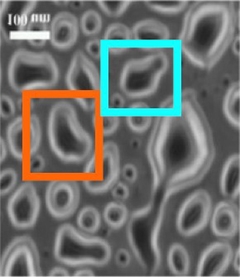FUS Phase Transitions: Liquids and Gels
Quick Links
The toxic activity of FUS, a protein linked to both amyotrophic sclerosis and frontotemporal dementia, may come down to a question of liquids versus solids. Today in Neuron, researchers led by Peter St. George-Hyslop of the University of Cambridge in England and the University of Toronto, Canada, report that the free-floating protein can condense first into liquids, then into two kinds of progressively thicker hydrogels containing fibrils. St. George-Hyslop will discuss the findings in an Alzforum Webinar on October 30.

Drips and drops.
Cooling purified, wild-type FUS makes it spontaneously condense into a liquid form. [Courtesy of Neuron, Murakami et al.]
The new paper joins several recent studies finding that FUS, as well as the neurodegeneration-linked protein hnRNPA1, condense much like the morning dew into non-membrane-bound organelles that house RNAs and associated proteins (see Sep 2015 news; Oct 2015 news).
The paper published in Neuron reflects four years’ worth of work by co-first authors Tetsuro Murakami of the University of Toronto, and Seema Qamar, Julie Qiaojin Lin, and Gabriele Schierle of the University of Cambridge, and colleagues. They analyzed wild-type and mutant FUS in vitro, in nematodes, and in cultured cells to delineate four possible protein phases. Two are relatively fluid: Individual FUS molecules can move individually, in a manner akin to gaseous particles, or condense into liquid-like droplets. These liquids hold in RNAs and their associated proteins, thus creating RNA-storing organelles such as stress granules.
Further, the liquid can turn into two phases of hydrogel, watery substances held together by polymers. One was reversible, and thus not dangerous for the cell, but the other was irreversible and toxic. FUS mutations that cause neurodegeneration prod the protein toward the most viscous—and vicious—state, though wild-type FUS can also solidify past the point of no return.
The authors posit that the reversible hydrogels may benefit the cell by stabilizing the liquid organelles. The permanent fibrils, however, were toxic to nematodes and cells. In part, this was explained by their propensity to ensnare other RNA-processing proteins including, notably, those required for protein synthesis in axon terminals.—Amber Dance
References
Webinar Citations
News Citations
Further Reading
Papers
- Weber SC, Brangwynne CP. Inverse size scaling of the nucleolus by a concentration-dependent phase transition. Curr Biol. 2015 Mar 2;25(5):641-6. Epub 2015 Feb 19 PubMed.
- Berry J, Weber SC, Vaidya N, Haataja M, Brangwynne CP. RNA transcription modulates phase transition-driven nuclear body assembly. Proc Natl Acad Sci U S A. 2015 Sep 22;112(38):E5237-45. Epub 2015 Sep 8 PubMed.
- Gilks N, Kedersha N, Ayodele M, Shen L, Stoecklin G, Dember LM, Anderson P. Stress granule assembly is mediated by prion-like aggregation of TIA-1. Mol Biol Cell. 2004 Dec;15(12):5383-98. Epub 2004 Sep 15 PubMed.
- Decker CJ, Teixeira D, Parker R. Edc3p and a glutamine/asparagine-rich domain of Lsm4p function in processing body assembly in Saccharomyces cerevisiae. J Cell Biol. 2007 Nov 5;179(3):437-49. PubMed.
Primary Papers
- Murakami T, Qamar S, Lin JQ, Schierle GS, Rees E, Miyashita A, Costa AR, Dodd RB, Chan FT, Michel CH, Kronenberg-Versteeg D, Li Y, Yang SP, Wakutani Y, Meadows W, Ferry RR, Dong L, Tartaglia GG, Favrin G, Lin WL, Dickson DW, Zhen M, Ron D, Schmitt-Ulms G, Fraser PE, Shneider NA, Holt C, Vendruscolo M, Kaminski CF, St George-Hyslop P. ALS/FTD Mutation-Induced Phase Transition of FUS Liquid Droplets and Reversible Hydrogels into Irreversible Hydrogels Impairs RNP Granule Function. Neuron. 2015 Nov 18;88(4):678-90. Epub 2015 Oct 29 PubMed.
Annotate
To make an annotation you must Login or Register.

Comments
No Available Comments
Make a Comment
To make a comment you must login or register.